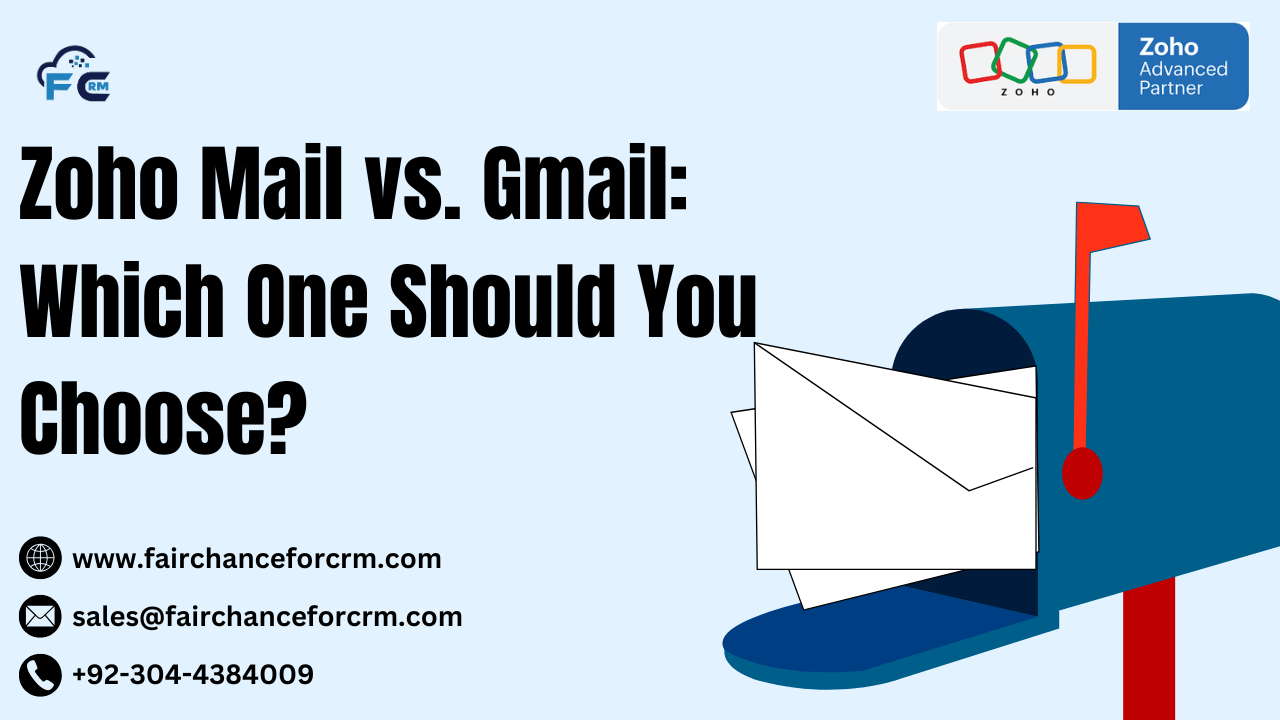Today our topic is about Zoho Mail vs. Gmail. Selecting the best email service provider is essential for effective communication in the digital age. Two of the most popular options are Gmail from Google and Zoho Mail from Zoho Corporation. While Zoho Mail is tailored to business purposes and provides a number of productivity features, Gmail is well-known for its user-friendly layout and seamless connection with Google’s suite of apps.
If you’re still unsure, consulting a Zoho Mail vs. Gmail certified consultant might be the best course of action.
Also Read:
- 9 Exclusive Benefits of Salesforce CRM – FAIRCHANCE FOR CRM
- Social CRM: Why It’s Crucial for Modern Businesses?
- Zoho Recruit: A Game-Changer for Streamlining Recruitment
- Zoho CRM and NetSuite Integration – FAIRCHANCE FOR CRM
- Zoho Workspace vs Google Workspace – FAIRCHANCE FOR CRM
Important Points about Zoho Mail vs. Gmail
What is Zoho Mail?
A safe, ad-free business email service, Zoho Mail comes with a slew of features to improve communication and productivity. For companies of all sizes, it offers an all-in-one solution with close connectivity between Zoho apps and external apps. It’s recognized as one of the safest and most private email services out there.
Key Features of Zoho Mail
Streams: Allows for easy communication with colleagues by sharing posts, tagging team members, assigning tasks, and scheduling events.
- Email Sharing: Collaborate on email templates or tag team members in specific emails to easily share information.
- Email Retention and eDiscovery: Zoho Mail allows businesses to store and retrieve emails, ensuring compliance with retention policies.
- eWidget: This panel allows Zoho Mail to connect with other Zoho products and third-party apps, enabling users to perform various tasks from within their inbox.
- Control Panel: Administrators have full control over email accounts, security settings, and other organizational configurations through a comprehensive control panel.
What is Gmail?
Gmail, powered by Google, is one of the most widely used email services globally. It offers a simple interface with powerful search features and 15 GB of free storage, shared across Google Drive and Photos. Gmail is a robust tool for both personal and professional use, known for its user-friendliness and seamless integration with other Google services.
Key Features of Gmail
Here are some of the features that make Gmail a popular choice:
- Labeling and Sorting: Helps keep your inbox organized by allowing you to sort and label emails.
- Mobile App: Gmail’s mobile app provides a smooth experience, allowing users to manage their email on the go.
- Email Scheduling: You can schedule emails to be sent at a later time, ensuring timely communication.
- Undo Send: This feature allows you to retract an email within a specific timeframe after hitting send.
- Create Automation Rules: Automate your inbox with rules that help manage incoming emails, saving you time and effort.
Zoho Mail vs. Gmail: A Feature Comparison
To decide which service fits your needs better, here’s a side-by-side comparison of key features:
1. Viewing Emails
- Zoho Mail: Offers a conversation view with the option to display emails chronologically. You can choose between vertical, horizontal, new tab, or new window layouts for viewing.
- Gmail: Displays emails in conversation threads, with the most recent message at the bottom of the thread. Gmail also allows you to configure the reading pane view.
2. Managing Attachments
- Zoho Mail: Features an Attachment Viewer that consolidates all attachments in your mailbox. Attachments can be opened in the browser directly from emails.
- Gmail: Shows attachments as thumbnails at the top of each email, making them easy to access.
3. Sending Emails
- Zoho Mail: Allows users to reply, forward, print, and undo send emails. Email templates can also be created and saved for future use.
- Gmail: Also supports reply, forward, print, and undo send, with the ability to create standard templates.
4. Suite of Applications
- Zoho Mail: Integrates several apps, including Calendar, Tasks, Notes, and Contacts, all accessible from the mail dashboard.
- Gmail: Allows access to Calendar, Keep (notes), and Tasks through a sidebar within the Gmail interface.
5. Search Filters
- Zoho Mail: Offers powerful search filters to find emails, tasks, events, and notes across your inbox.
- Gmail: Provides a search bar with operators that help narrow down specific emails.
6. Composing Emails
- Zoho Mail: Supports attachments up to 1 GB, which are converted into links for easier handling. The Spell Check feature helps correct grammar and spelling.
- Gmail: Allows attachments up to 25 MB, with larger files sent via Google Drive. Spell check and auto-correct options are available for composing emails.
7. Storage
- Zoho Mail: Offers 5 GB of free storage for its forever-free plan. The Mail Lite plan provides 10 GB, while premium users can get up to 50 GB.
- Gmail: Provides 15 GB of free storage, but this is shared across Google Drive and Google Photos, potentially limiting space for emails.
8. Out-of-Office Replies
- Zoho Mail: Supports automated out-of-office responses for incoming emails, excluding automated ones.
- Gmail: Includes a vacation responder feature, which allows users to send automated replies when they are unavailable.
Which One Should You Choose?
Both Zoho Mail and Gmail offer robust email solutions, but the choice largely depends on your specific needs:
- Zoho Mail is a better option for companies, particularly those that want greater control over security and administrative settings along with strong interaction with a variety of productivity tools. It is excellent for business-focused functionality, collaborating via email, and handling huge attachments.
- Gmail is ideal for users who rely heavily on Google’s ecosystem and need a user-friendly interface with excellent search capabilities. It is the preferred option for individual or small company use due to its smooth interaction with Google Drive and other Google services.
The best option ultimately comes down to your priorities, including whether you require additional storage, sophisticated business features, or ease of use. When selecting your choice, take into account your workflow, communication demands, and integration requirements.
For more information about the Zoho Mail vs. Gmail, visit this link.
If you want to Free Trail Zoho, click on this link.




